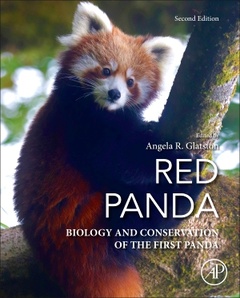Red Panda (2nd Ed.) Biology and Conservation of the First Panda
Coordonnateur : Glatston Angela R.

Red Panda: Biology and Conservation of the First Panda, Second Edition, provides the most up-to-date research, data, and conservation solutions for the red pandas, Ailurus species. Since the publication of the previous edition in 2010, the International Union for Conservation of Nature (IUCN) updated the threat level of red pandas, and they are now considered to be endangered. This latest edition is updated to provide an in-depth look at the scientific and conservation-based issues urgently facing the red panda today.
Led by one of the world?s leading authorities and advocates for red panda conservation, this new edition includes data from the Population and Habitat Viability (PHVA) workshops conducted in three of the species? range states, Nepal, China, and India; these workshops utilized firsthand information on the decrease of red panda populations due to factors including deforestation, illegal pet trade, human population growth, and climate change. This book also includes updated information from the first edition on reproduction, anatomy, veterinary care, zoo management, and fossil history.
1. People and Red Pandas: The Red Panda's Role in Economy and Culture 2. The Evolution of the Family Ailuridae: Origins and Old-World Fossil Record 3. Systematic Revision of the Ailurinae (Mammalia: Carnivora: Ailuridae) With a New Species From North America 4. Phenotypic and Geographic Diversity of the Lesser Panda Parailurus 5. Red Panda Anatomy 6. The Taxonomy and Phylogeny of Ailurus 7. Reproductive Biology of the Red Panda 8. Placentation of the Red Panda 9. Early Days: Maternal Behavior and Infant Development 10. A Brief History in Captivity 11. Red Panda Husbandry for Reproductive Management 12. Red Panda Nutrition: How to Feed a Vegetarian Carnivore 13. Captive Red Panda Medicine 14. Red Panda Pathology 15. Management, Husbandry and Veterinary Medicine of Red Pandas Living Ex-Situ in China, Using the Chengdu Panda Base as a Model 16. The Role of Ex-Situ Management in the Conservation of Red Pandas 17. What Can Studbook Data Reveal About Effects of Climate on Neonatal Survival and Seasonality in Births - 18. Red Panda Ecology 19. Bamboo Distribution in Nepal and Its Impact on Red Pandas 20. The Impact of Climate Change on Extant Ailurids 21. Red Pandas in the Wild in China 22. Red Panda Genomics and the Evidence for Two Species 23. The Conservation Status of the Red Panda and the Implication of the New Evidence of Two Species 24. Monitoring Red Pandas from Indian Himalayan Region: Implications in Conservation and Management of Free Ranging Populations 25. The Status, Distribution and Conservation of Red Panda Ailurus fulgens in Bhutan 26. The Conservation Status of the Red Panda in North-East Myanmar 27. Red Pandas: An Updated Analysis of Threats Caused by Trade 28. Red Pandas in Nepal: A Community-Based Approach to Landscape-Level Conservation 29. Conservation Initiatives in China 30. Records and Reports of Red Pandas, Ailurus fulgens, from Areas with Warm Climates 31. Synthesis
- Discusses the evidence for two species of red panda and how this might impact conservation efforts
- Reports on status in the wild, looks at conservation issues and considers the future of this unique species
- Written by long-standing red panda experts as well as those specializing in fields involving cutting-edge red panda research
- Includes new chapters on topic including the impact of climate change, how bamboo influences distribution, and conservation in Bhutan and Myanmar
Date de parution : 10-2021
Ouvrage de 608 p.
19x23.4 cm
Thèmes de Red Panda :
Mots-clés :
?Activity pattern; Adults; Age-specific fertility; Age-specific mortality; Ailuridae; Ailurinae; Ailuropoda melanoleuca; Ailurus; Ailurus anglicus; Ailurus fulgens; Ailurus fulgens fulgens; Ailurus fulgens styani; Ailurus ochraceus; Ailurus refulgens; Allogrooming; Ambassador animals; Amphictis; Anatomy; Animal husbandry; Anomalously low altitudes; Anomalously warm climates; Antipoaching; Asia; Assam; Bamboo die-off; Bamboo distribution; Bamboo flowering; Behavioural management; Bhutan; Biological corridors; CITES; Camera trap; Captivity; Carnivore; Chimonobambusa; China; Chinese red panda; Citizen scientist; Climate; Climate change; Climatic niche; Coexistence; Community-based conservation; Comparative genomics; Conservation; Conservation genetics; Conservation genomics; Conservation initiative; Conservation projects; Cub transport; Culture; Diet; Diet preference; Distemper; Distribution; Dog management; Ecology; Ecotourism; Education; Elaphodus cephalophus; Embryonic diapause; Endangered species; Endangerment; Ex situ wildlife management; Feeding; Films; Flagship species; Forest guardian; Fundraising; Fur trade; Future climate; Genome; Gin trap; Glands; Gray fossil site; Habitat; Habitat loss; Habitat selection; Herding improvement; Heritability; Himalayan red panda; Homestay; Housing; Hunting; Husbandry; Image; Immobilization; Infant mortality; Insurance; Juveniles; Land cover; Landscape genetics; Lao PDR; Magerictis; Maximum entropy modeling modelling; Medicine; Meghalaya; Meta-population; Mount Imawbum National Park; Musculoskeletal system



